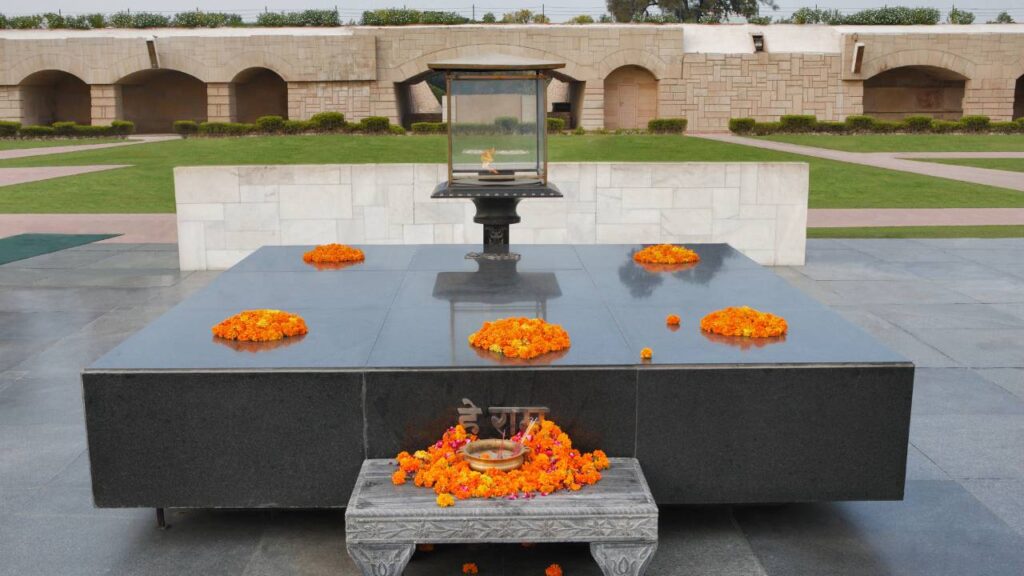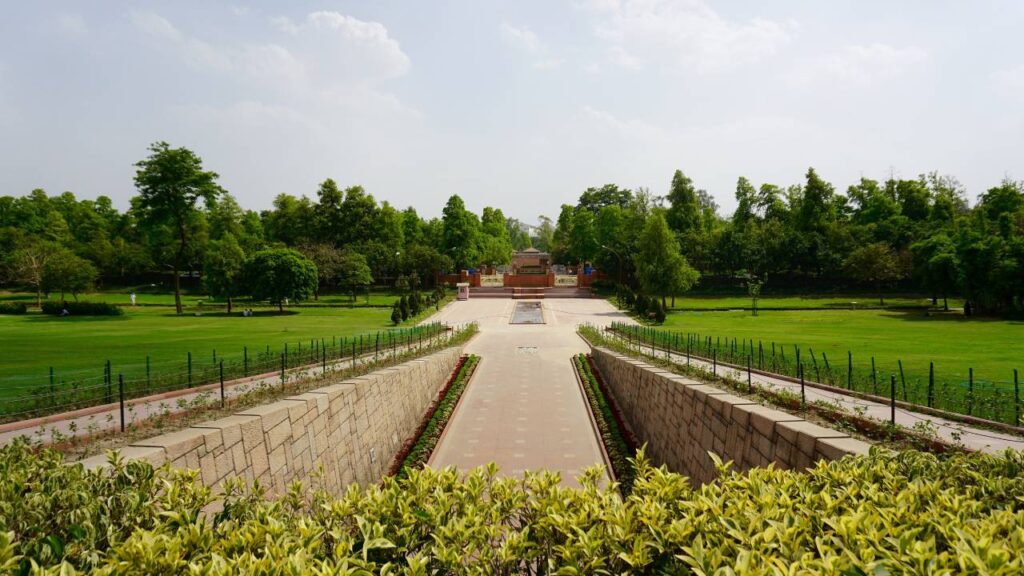Rajghat, situated along the serene banks of the Yamuna River in New Delhi, is one of India’s most sacred and symbolic landmarks. It is the cremation site of Mahatma Gandhi, the Father of the Nation, and serves as a peaceful memorial that draws visitors from across the globe. Surrounded by lush greenery and landscaped gardens, Rajghat is more than just a tourist destination—it is a place of reflection, remembrance, and reverence. A history enthusiast, a student of political science, or a curious traveler, this guide will provide you with everything you need to know about Rajghat, from its historical roots to travel tips for a meaningful visit.
Historical Significance of Rajghat
The story of Rajghat began on January 30, 1948, the day when an assassin took the life of Mahatma Gandhi. Officials chose the location—originally one of Delhi’s old ghats—for Gandhi’s cremation because of its close proximity to the Yamuna River and its central position in the capital. Today, a black marble platform at Rajghat marks the exact spot of his cremation. This simple yet powerful monument serves as a national shrine and constantly reminds visitors of Gandhi’s teachings of non-violence (Ahimsa), truth (Satya), and peace.

Craftsmen inscribed the words “Hey Ram”—believed to be Gandhi’s final utterance—on the memorial. An eternal flame burns at one end of the platform, symbolizing the everlasting presence of his legacy. Authorities maintain the site with deep respect and welcome thousands of visitors every year, including heads of state, dignitaries, political leaders, school children, and foreign tourists. People especially gather at Rajghat on Gandhi Jayanti (October 2) and Martyrs’ Day (January 30) to attend commemorative services, offer prayers, and reflect on his life and message.
Rajghat Location and How to Reach
Located in central Delhi, Rajghat sits on Mahatma Gandhi Road, just off the bustling Ring Road, making it one of the most easily reachable heritage sites in the city. Its prime location between iconic landmarks like the Red Fort and Shakti Sthal makes it a natural and essential stop on any historical, political, or cultural tour of New Delhi. The old Mughal architecture or paying tribute to India’s independence movement, a visit to Rajghat provides a seamless and enriching addition to your itinerary. The area around the memorial is clean, green, and peaceful, offering a calm respite from the city’s chaos.
Getting There:
By Metro:
The nearest metro station to Rajghat is Indraprastha Metro Station on the Blue Line, located about 1.5 kilometers away. This metro line connects major parts of the city, including Connaught Place, Pragati Maidan, and Dwarka. From the station, you can hire an auto-rickshaw, hop into a cycle rickshaw, or even walk if you prefer to enjoy the local streets. The walk takes about 15–20 minutes through clearly marked lanes and shaded footpaths, offering views of nearby heritage spots and gardens.
By Bus:
The Delhi Transport Corporation (DTC) operates a dense network of buses that connect various parts of the city to Rajghat. You can catch buses heading toward Delhi Gate, ITO, Red Fort, or Rajghat Depot. These buses are frequent and budget-friendly, making them an ideal option for local commuters and budget travelers. In addition, Cluster Buses and Hop-On-Hop-Off (HOHO) buses often include Rajghat in their designated routes, especially during tourist seasons.
By Cab or Ride-Sharing Services:
App-based ride services like Uber, Ola, and Rapido are readily available throughout Delhi. These platforms offer real-time navigation, fixed pricing, and various vehicle types to choose from—including air-conditioned cars, two-wheelers, and auto-rickshaws. Ride-sharing services are especially useful for tourists who may not be familiar with public transport or want to travel directly without transfers. Drivers usually drop you off close to the Rajghat gate, and pickups are easily coordinated through the apps.
By Private Car:
For travelers using private vehicles, Google Maps provides highly accurate turn-by-turn directions. Rajghat is well-signposted, and the roads leading to it are well-maintained. You can follow the signage from major junctions like ITO, Delhi Gate, or Daryaganj to reach the site smoothly. There is a dedicated parking area nearby, but visitors should note that parking spaces may become limited on special days such as Gandhi Jayanti or Martyrs’ Day, when large crowds gather for commemorative events. In such cases, it’s advisable to arrive early or use public transport.
Rajghat Tickets and Entry Fee Information
One of the most commendable aspects of Rajghat is that entry is absolutely free for all, whether you are a local visitor or an international tourist. This is in keeping with the values of Mahatma Gandhi, who believed in equality and accessibility for everyone.
You don’t need to worry about any entry charges, security deposits, or booking in advance. Visitors can walk in and visit the premises during the official opening hours. There is no restriction on using mobile phones for photography, though you are expected to be respectful and avoid taking pictures in solemn or prayer areas.
If visiting as part of an educational or heritage group, Delhi Tourism and local guides often provide free walking tours or affordable guide services upon prior request. Those planning for documentary shoots or professional photography may need to obtain special permissions from the administration.
Rajghat Opening Hours and Best Time to Visit
Rajghat welcomes visitors seven days a week, throughout the year, making it an easily accessible site for both domestic and international tourists. As a memorial that represents peace and simplicity, it maintains a serene environment at all times. The best experiences at Rajghat are during the early morning hours, when the sun rises gently over the Yamuna River and casts a soft glow on the black marble platform. Similarly, visiting just before sunset allows you to witness the changing colors of the sky reflecting on the landscaped gardens and stone structures, adding to the tranquil atmosphere.

This site remains relatively peaceful early in the day, which allows visitors to absorb the atmosphere without the hustle and bustle of large crowds. Early hours are ideal for those interested in photography, meditation, or a quiet walk through the memorial, as the natural lighting enhances the aesthetic appeal and reverence of the place.
Timings:
- Opening Hours: 6:30 AM – 6:00 PM (Monday to Sunday)
The memorial opens shortly after sunrise and closes by sunset, following the natural daylight schedule. Since Rajghat is an open-air site, operations stop once daylight fades, ensuring visitor safety and preserving the sanctity of the memorial. While it is open throughout the day, the early morning and late afternoon hours are considered the most pleasant times to visit, as the weather is cooler and the setting is quieter.
Planning to visit on national holidays like Gandhi Jayanti (October 2) or Martyrs’ Day (January 30), arrive early as security is heightened and larger crowds are expected. These dates also offer a more ceremonial experience, with prayers, floral tributes, and speeches by political leaders and dignitaries.
Best Season to Visit:
The ideal time to visit Rajghat is from October to March, when Delhi’s weather is at its most comfortable. During these months, daytime temperatures remain mild, ranging between 12°C to 25°C (54°F to 77°F), and the air is generally clearer. The gardens around Rajghat flourish in the winter and post-monsoon months, providing a vibrant green backdrop for visitors. The pleasant weather also makes it easier to combine Rajghat with other nearby attractions like Red Fort, Jama Masjid, or India Gate as part of a full-day heritage tour.
Avoid planning your visit between April and June, as Delhi’s summer can be intensely hot, with temperatures often exceeding 42°C (107°F). Walking outdoors during this period can be physically taxing, especially for elderly visitors or young children. Additionally, the monsoon season (July to September) brings unpredictable rain, which may limit access to the gardens or affect walking conditions.
For the most enriching experience, plan your trip during the early winter months, when cultural and educational groups also organize guided tours, providing additional insights into the life and legacy of Mahatma Gandhi.
What to See at Rajghat
Rajghat is not merely a single monument—it’s a thoughtfully designed memorial complex that invites visitors to reflect, learn, and connect with the legacy of Mahatma Gandhi. Spread over acres of serene green space on the banks of the Yamuna River in New Delhi, Rajghat offers a peaceful retreat from the busy pace of the city. Visiting for historical interest, personal inspiration, or educational reasons, here’s what you can expect to visit and experience at Rajghat:
1. The Marble Samadhi (Cremation Platform)
At the heart of the complex lies the black marble Samadhi, a striking and solemn platform that marks the exact spot where Mahatma Gandhi was cremated on January 31, 1948, a day after his assassination. The platform is elegantly minimal, allowing its symbolism to speak for itself. It is enclosed by a simple stone railing and is open to the sky, symbolizing purity, truth, and Gandhi’s transparent life.
An eternal flame encased in brass flickers continuously at one end of the platform, representing the everlasting impact of Gandhi’s teachings on the world. Visitors often come forward in silence to lay floral tributes, bow their heads in respect, or sit nearby in quiet contemplation. Dignitaries, politicians, and global leaders regularly visit the Samadhi to pay homage during significant national occasions. The calm that envelops this area is palpable, encouraging introspection and peace.
2. Landscaped Gardens & Pathways
The surrounding gardens are a testament to Gandhi’s love for nature and simplicity. These well-maintained lawns, interspersed with seasonal flowers, fountains, and shade-giving trees, create a tranquil environment that feels far removed from the city’s chaos. Visitors can walk barefoot on the cobblestone or granite pathways that respectfully guide you through the memorial without disturbing its sanctity.
Benches and shaded spots under neem and peepal trees are available, offering a quiet corner for those who wish to meditate or take in the solemnity of the space. You may spot groups of schoolchildren on guided tours, families learning about Indian history, or individuals sitting cross-legged under a tree in silent prayer. These gardens also serve as venues for open-air discussions or readings related to Gandhi’s life and teachings, often organized by educational groups.
3. Prayer and Meditation Spots
Gandhi was deeply spiritual, and the Rajghat memorial honors this aspect through designated areas for prayer and meditation. These spots are typically used during official commemorative events, including Gandhi Jayanti (October 2) and Martyrs’ Day (January 30), when national prayers and public gatherings take place. Devotional hymns, including Gandhi’s favorite “Vaishnav Jan To” and other bhajans, echo across the grounds, creating a deeply moving atmosphere.
While these areas are usually off-limits for personal use, visitors can still observe the ceremonies and soak in the spiritually enriching ambiance. On regular days, the same spaces are available for peaceful reflection, encouraging a moment of silence and inner peace—something Gandhi valued deeply throughout his life.
4. Information Boards & Gandhi Quotes
One of the most educational elements of Rajghat is the array of well-placed information boards, showcasing quotes, milestones, and philosophical thoughts of Gandhi. As you walk along the paths, you’ll come across plaques inscribed with his timeless teachings on non-violence (Ahimsa), truth (Satya), equality, freedom, and human dignity.
These boards do more than just inform—they inspire. They are presented in both Hindi and English, making them accessible to a wide range of visitors. Many of these quotes are thought-provoking and are drawn from Gandhi’s speeches, letters, and writings from the Indian freedom movement. Some visitors even take time to write down their favorite quotes or take photos to carry a piece of Gandhi’s wisdom with them.
Rajghat and Nearby Attractions
While Rajghat itself is a profound historical and spiritual site, its location in New Delhi places it amid several other important landmarks that collectively narrate India’s rich political and cultural history. Visiting these nearby attractions can enrich your visit, giving you a broader perspective of the country’s freedom struggle and heritage.
1. Shanti Van
Just adjacent to Rajghat lies Shanti Van, the cremation site of Jawaharlal Nehru, India’s first Prime Minister and a pivotal figure in the country’s independence movement. Like Rajghat, Shanti Van is set within beautifully landscaped gardens designed to evoke peace and solemnity. The site includes a black marble platform similar in style to Gandhi’s memorial, symbolizing Nehru’s commitment to secularism and democratic ideals.
Visitors often find this location quieter and less crowded, offering a contemplative space to honor Nehru’s legacy, which includes his vision for modern India and his contributions to establishing institutions of learning and governance.
2. Vijay Ghat
Close to Rajghat, you will find Vijay Ghat, dedicated to Lal Bahadur Shastri, India’s second Prime Minister, remembered fondly for the inspiring slogan “Jai Jawan Jai Kisan” (Hail the Soldier, Hail the Farmer). The memorial here consists of a simple black marble platform and an eternal flame, reflecting Shastri’s humble personality and dedication to the nation’s agrarian and defense sectors.
Vijay Ghat is often included in historical tours that focus on India’s post-independence leadership, providing insight into the country’s early years of growth and resilience.
3. Red Fort (Lal Qila)
Only about 2 kilometers from Rajghat, the Red Fort, also known as Lal Qila, stands as a symbol of India’s rich Mughal heritage and its struggle for independence. This sprawling UNESCO World Heritage Site was commissioned by Emperor Shah Jahan in the 17th century and served as the main residence of Mughal emperors for nearly 200 years.
Today, the fort attracts millions of visitors annually, especially during India’s Independence Day celebrations on August 15, when the Prime Minister hoists the national flag from its ramparts. The Red Fort’s impressive red sandstone walls, ornate palaces, and historical museums provide a vivid glimpse into India’s imperial past and cultural grandeur.
4. Jama Masjid
Located just a short distance from Rajghat, the Jama Masjid is one of the largest and oldest mosques in India, constructed by Shah Jahan between 1644 and 1656. Its grand architecture, featuring towering minarets, massive courtyards, and intricate marble inlays, exemplifies the pinnacle of Mughal architectural excellence.
Visitors to Jama Masjid can experience not only the spiritual atmosphere but also panoramic views of Old Delhi from the mosque’s minarets. The mosque remains a vibrant center of worship and a key tourist attraction, offering cultural insights into Delhi’s Islamic heritage and its diverse religious fabric.
5. National Gandhi Museum
Situated directly across the road from Rajghat, the National Gandhi Museum provides a comprehensive and deeply moving exploration of Mahatma Gandhi’s life, philosophies, and role in India’s freedom struggle. The museum houses an extensive collection of photographs, original manuscripts, letters, and personal belongings of Gandhi, including his iconic glasses and spinning wheel (charkha).
Exhibits also chronicle significant events such as the Salt March and the Quit India Movement. This museum is an invaluable resource for students, historians, and travelers seeking a deeper understanding of Gandhi’s enduring impact on India and the world.
Rajghat Visitor Tips for a Memorable Experience
To truly appreciate the significance of Rajghat and enjoy your visit, follow these practical and respectful tips that enhance both your experience and that of others around you.
Dress Appropriately:
Wear modest, comfortable clothing suitable for a place of reverence and reflection. Lightweight fabrics are ideal for Delhi’s climate, especially if you plan to spend time walking or sitting in quiet prayer areas. Avoid flashy or revealing attire to respect the solemn atmosphere of the memorial.
Maintain Silence and Respect:
Rajghat serves as a peaceful memorial honoring Mahatma Gandhi’s legacy. Keep your voice low and avoid loud conversations, shouting, or playing music. Switch your mobile phone to silent mode and refrain from using it in the main memorial zone to maintain the decorum and respect the sentiments of other visitors.
Carry Water and Sun Protection:
Delhi’s heat can be intense, particularly between April and June. Bring a reusable water bottle to stay hydrated throughout your visit. Also, wear a hat or cap and apply sunscreen generously to protect yourself from strong sunlight, especially if you plan to visit the surrounding gardens and pathways.
Practice Photography Etiquette:
You may take photos of the grounds and monuments, but avoid selfies or group pictures near the cremation platform or during prayer ceremonies. This ensures the memorial’s sanctity is preserved and does not disturb others who come for quiet reflection. Always ask for permission before photographing individuals or groups.
Use Guided Tours for Deeper Insight:
Consider hiring a knowledgeable local guide or joining a small group tour to gain a richer understanding of Rajghat’s historical, cultural, and political significance. Guides often share lesser-known stories about Gandhi’s life and the freedom movement, making your visit more meaningful.
Combine Your Visit with Nearby Attractions:
Plan your day efficiently by combining Rajghat with other nearby landmarks like the Red Fort, India Gate, Shakti Sthal, and the National Gandhi Museum. This creates a comprehensive historical itinerary and helps you experience the rich heritage of New Delhi in one trip.
Weekend Getaways from Delhi Under 200 Km for a Quick Refresh
FAQs
1. What is Rajghat?
Rajghat honors Mahatma Gandhi as the exact site of his cremation in New Delhi. It symbolizes peace and Gandhi’s teachings of non-violence.
2. Where exactly is Rajghat located?
Rajghat sits on Mahatma Gandhi Road, beside the Yamuna River, right in the heart of New Delhi. Because of its central location, visitors easily access it from various parts of the city.
3. When did Rajghat come into existence?
Following Gandhi’s assassination on January 30, 1948, officials quickly established Rajghat as a memorial. Since then, it has become a respected national shrine.
4. What are Rajghat’s opening hours?
Rajghat opens every day from 6:30 AM to 6:00 PM. Therefore, visitors can enjoy the memorial comfortably during daylight.
5. Do visitors need to pay an entry fee at Rajghat?
No, the government allows free entry to Rajghat, encouraging everyone to visit and pay their respects without any financial barrier.
6. How can visitors reach Rajghat using public transport?
Visitors can take the Blue Line Metro to Indraprastha Station, which is about 1.5 km from Rajghat. From there, they can walk or hire an auto-rickshaw for a quick ride.
7. When is the best time to visit Rajghat?
The best time to visit Rajghat falls between October and March when the weather stays cool and pleasant. Additionally, early mornings and late afternoons offer a peaceful atmosphere with fewer crowds.
8. Can visitors join guided tours at Rajghat?
Yes, many local guides provide detailed tours. By joining these, visitors gain deeper insights into Gandhi’s life and the memorial’s history.
9. Is photography allowed at Rajghat?
Visitors can freely take photographs around the memorial. They should avoid taking selfies or group photos near the cremation platform or during prayer ceremonies to respect the solemn environment.
10. What other nearby attractions can visitors enjoy?
Besides Rajghat, visitors can visit landmarks such as the Red Fort, National Gandhi Museum, Shanti Van, and Vijay Ghat, which all lie close by and enrich the cultural experience.






